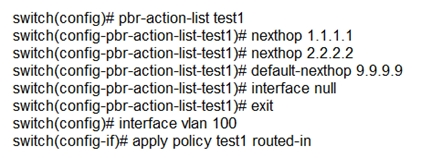Examine the commands entered on an AOS-CX switch:

What is true regarding this configuration for traffic received on interface 100?
Examine the commands entered on an AOS-CX switch:

What is true regarding this configuration for traffic received on interface 100?
In the provided configuration, the policy action list 'test1' checks for next-hop availability in sequence. If the first next-hop (1.1.1.1) is unreachable, it moves to the second next-hop (2.2.2.2). If both specified next-hops are unreachable, it attempts to use the default next-hop (9.9.9.9). Finally, if all these next-hop addresses are unreachable, the policy directs traffic to 'interface null', which results in dropping the traffic. Hence, the correct option is that the traffic is always dropped if the next-hop addresses are unreachable.
Its B 1) Try NH 1.1.1.1 (Seq 10) 2) Try NH 2.2.2.2 (Seq 20) 3) Try default NH 3.3.3.3 (Seq 30) 4) Match interface null, which means drop the packet. (Seq 40) C is not correct, as interface null action will drop packets before the fallback to routing table can be leveraged.
Yes, but if the sentence its correct when NH its 1.1.1.1 not apply the dropped packet
"interface null: equivalent to the policy drop policing action. Any packets matching the class criteria for that policy entry will be dropped and not routed any further." https://www.arubanetworks.com/techdocs/AOS-CX/10.05/HTML/5200-7300/index.html#GUID-DC7E5E47-8F31-4DE4-B257-1A68665B2AF4.html
C is correct... If 1.1.1.1 is not reachable then next hop uses 2.2.2.2 if both of these are unreachable then normal routing table is used..and only if no route is available in routing table then default next-hop will kick-in
Answer is B interface null means that if all three are unreachable packets are dropped, only B works for me: The active entry is the one with the lowest sequence number – the one entered first, by default. (1.1.1.1) This next hop is used exclusively unless that address becomes unavailable. Within 5 seconds, the router uses the next entry – 2.2.2.2. If both of those are down, then the router uses the default- nexthop 9.9.9.9. If all three are down, the interface null action ensures packets are merely thrown away. If you omit the interface null command, then the router falls back to using destination- based route table entries.
I think it's b. PBR action list works like an ACL. Every entry is checked one by one and the first match is used. If the next hops are unavailable they don't match and it comes to interface null which iss the equivalent to dropping traffic.
I think its C. If nexthop 1.1.1.1 is unreachable it will try nexthop 2.2.2.2.. If that one is also unreachable it will go toward the default-nexthop policy. Book explains default-nexthop as: Used if no specific route exists in routing table. So i believe it will first look at the routing table to foward the traffic, if there is no route there.. It will try 9.9.9.9, if that one is also unreachable he will drop the traffic because of interface null.
Agree - Answer B is not correct as traffic will NOT ALWAYS beeing dropped - only if no routing entry exists AND default-nexthop is unreachable.
i think its C
Page 905 Study Guide: The figure shows that 4 packets have arrived at some interface, sitting in a queue, waiting for service. If the ingress buffer used a single queue, Head Of Line (HOL) blocking could delay traffic. This occurs when the first packet in the queue (at the “head of the line”) is destined out a congested port, it delays all packets behind it, even though those that are destined to noncongested ports. | AOS- CX switches use an intra- switch queuing method called Virtual output Queuing ( VoQ ). VOQ prevents this problem by providing deep ingress buffers with separate queues for each egress port. [Aruba Networks]
The answer is B it will fall thru like an ACL
B should be the correct one.
B is correct
Answer is B. A PBR action list is processed from the top down like an ACL. After the three nexthop entries, there's an interface null entry. This will drop all traffic that matches on the pbr-action-list.
D is correct: the second instruction overwrite the first one.
I must correct myself. I think it's C. More than one next hop can be assigned with an ACL and they work by priority (based on the sequence number: lower sequence number -> higher priority). So next-hop 2.2.2.2 will be used if 1.1.1.1 is not reachable. If both are unreachable, then the packet will be routed looking at the default routing table, if no specific entry will be found, then the pacjet will be routed to the default next hop defined in the ACL.
From manual: If none of the routers in the list are reachable, the packet may be dropped (through the null interface entry if configured) or forwarded according to a system route table entry.
I think C is correct, firstly 1.1.1.1, if not active ->2.2.2.2, if not active->Routing Table, if no matched-> 9.9.9.9, if not active-> interface Null.
B: If none of the routers in the list are reachable, the packet may be dropped (through the null interface entry if configured) or forwarded according to a system route table entry.
Answer: B.
B: is the closest: If none of the routers in the list are reachable, the packet may be dropped (through the null interface entry if configured) or forwarded according to a system route table entry.